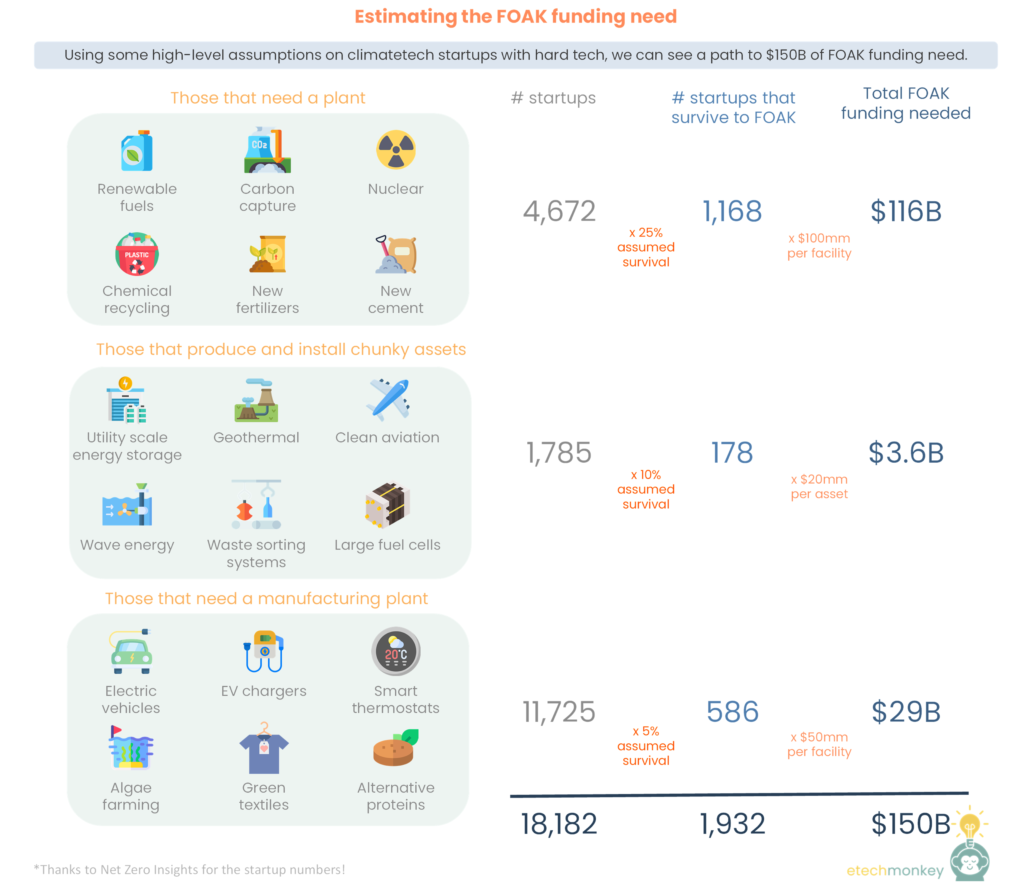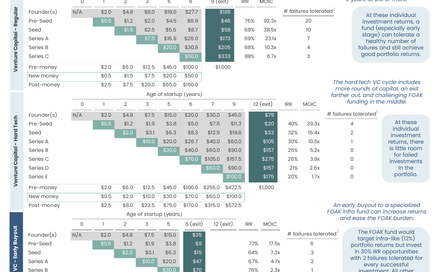
How much FOAK funding do we need?

After discussing types of FOAK last week, this week I wanted to see if I could find a good estimate for the amount of FOAK funding we need.
One way to look at this is to try to pare down estimated infrastructure spend to what will be spent on FOAK technologies.
Most infra spend estimates land at ~$4 to $9 trillion / year. These numbers are never detailed enough to understand specific technologies they’re actually building in, but we can kind of glean from the breakouts an upper-end limit for what spend might be:
- IEA estimates ~$4.5 - 5 trillion / year spend. $630 billion of this (~14%) will be from CCUS and hydrogen, both technologies that will likely need either large assets or large plants. Another $832 billion (another 18%) will come from batteries, another area that is far from being commercially mature. Add in new bioenergies, low carbon industrial processes, and non-wind/solar/hydro renewables and total infra spending from technologies not yet scaled could be 45% of 2050 investment or $2T. (As a sanity check, IEA also estimates that 45% of the emissions reduction that’s needed by 2050 comes from technologies not yet past demo stage, so this number is pretty consistent with that.)
- GFANZ estimates a $4.5 trillion / year spend. They don’t break it down by technology as nicely as IEA does but their end us sectors are similar: adding together the $359mm on industry decarbonization, $218mm on low emissions fuels, $161mm on ag/food, and a fraction (I use 30%) of the $3T they estimate will be used for electricity and transport, ~36% or $1.6T can be from technologies not yet scaled.
- McKinsey estimates a $9.2 trillion / year average annual spend by 2050. $4.5 trillion (~49%) of this is on low emissions assets. I’ve estimated using their sector breakdown and their low emissions asset spend number that this $4.5 trillion includes: $1.2T on new mobility and power, $100B from new industry, $280B from new ag/food, and $200B from new hydrogen/biofuels/heat. This totals to ~$1.8T spent on new technologies.
So all of the estimates roughly point to $1.5 - 2T / year being spent on technologies that have not yet scaled. Over the next 28 years, that’s $42 – 56T in total. Let’s just call it $50T as a midpoint.
To estimate how much we’d need for FOAK, we can just ballpark how much funding we can assign to deployed facilities (2nd facility and beyond) for every FOAK – or, assuming FOAK cost is around the commercial cost, basically how many deployed facilities for every FOAK facility. As one bookend, we can say that 1 out of every 100 facilities requires a FOAK. This is very high level but not crazy to assume. There are only 109 biodiesel plants in the US, 31 years after the first biodiesel plant in Kansas. There are only 18 renewable diesel plants (5 - 6 current renewable diesel plants with another 12 under construction), 12 years after the first renewable diesel plant in Louisiana. Using 1/100, that means we’d need to spend $500B for FOAK assets.
Another bookend would be looking at solar farms as a comp. There are 2,500 solar farms in the US, 39 years after the first solar farm in California. Let’s assume there’s 4 different types of PV (monocrystalline, polycrystalline, multijunction, and thin film) and that these 2,500 only needed 4 FOAKs (probably a very wrong assumption). If we assume 4 out of every 2,500 facilities requires a FOAK, we’d need $80B for FOAK assets.
So somewhere between $80B - $500B is probably the right number here…
To put this into context, PE funding in cleantech is at around $20 – 25B / year, while late stage VC funding is at ~$24B / year. If all of this funding was directed towards FOAK, we’d have enough…but part of this funding is used for digital technologies and for stages other than FOAK. If we assume that we have to put all of the FOAK in place by the halfway mark, we only really have $700B in place for potential FOAK funding. At the low end, 11% of our late stage – PE capital should be directed to FOAK. At the high end, 70% of that capital should be directed to FOAK.
I can tell you anecdotally that that true percentage of capital being directed to FOAK is nowhere near 11%, much less 70%.
If you’re not convinced by this top-down method of estimating potential FOAK spend, we can try to do a bottoms-up approach. We can assume that each startup that survives to FOAK needs FOAK funding…so we need an estimate the number of climatetech startups that are out there that will survive to FOAK.
Using Net Zero Insights’ database, I isolated 32 key areas that will likely need chunky FOAK funding, separated by the approximate types they’ll be in:
- Large plants: DAC, CCUS, sustainable aviation fuels, nuclear, steel, alternative proteins, water treatment, cement, biofuels, hydrogen, recycling, chemical, petchem/plastic
- Large assets: aviation, CSP, geothermal, wave, hydro, offshore, energy generation, energy storage
- Large manufacturing factories: aquaculture, algae, maritime, textiles, EVs, micromobility, PVs, robotics, energy efficiency, built environment, and food/ag
18,182 startups were identified as being in these categories. Let’s assume that 25% of the large plants, 10% of large assets, and 5% of large manufacturing faciltiies make it to FOAK. At $100mm per FOAK, that would mean we need $193B in funding for FOAK with just the startups that exist today. If we attempt to get more granular on individual category funding needs and assume the large plants need an average of $100mm, assets need $20mm, and manufacturing facilities need $50mm, we get $150B. At $150 – 193B of FOAK need, we’d need 21 - 28% of late stage VC + PE capital directed to FOAK, implying that one out of every 4 of these late stage deals need to be funding a FOAK.
I realize that a lot of this exercise is very hand-wavey…but it does at a high level illustrate an important need to direct more funding to FOAK facilities. We either need to be deliberately setting targets for the proportion of institutional deals that are FOAK OR we need to be bringing more capital in the door to help fund FOAK. In that latter case, the government, non-profits, and non-traditional capital sources like family offices and sovereign wealth funds will play an important role.
TLDR; FOAK funding will cost us billions, likely hundreds of billions, of dollars. We need more funding directed to it.


